A Colorful and Agriculturally Rich Photo Essay
“I love Morocco – it’s a real challenge to all five senses. You think you know something, and you don’t. It’s wonderful. It keeps you on your toes that way.”
Amy Ryan, Actress

It was our first visit to Morocco, and as much research we did before arriving, we were not ready for the assault it had on all our senses. Our experience in Morocco exceeded our expectations, and it would be easy to write many articles on this magnificent country and its people. That can take time, but for now, we will capture the magic of the markets of Morocco that are world-famous and deservedly so.
The markets of Morocco were so intriguing and unique to photograph. The pictures depict best what the experience was like. The article will be a photo essay of the four markets we were most blown away by. Surprisingly each was unique in its own right, which made the experience even more captivating.
Our first travels with Intrepid Travel
Starting with a bit of background on the trip. I, Joelle, and my husband, brother, and sister-in-law spent 9 days in Morocco with Intrepid Travel. It was our first time using this tour company based out of Australia. We had only heard great things about their tours, and after experiencing one for ourselves, we can say we wholeheartedly agree. Our tour was the 7-night Premium Highlights. Our trip started in Casablanca, followed by Meknes, Fes, Bin Ouidane, and Marakesh, with many stops in between. We also extended our trip one day on either end of the Intrepid tour.
Their immersion into the local culture and traditions makes traveling with Intrepid an exceptional experience. Each group (ours was 12 people) is led by an expert leader who travels with you throughout the trip. Our leader was Hamid, and he was extraordinary. He is from a village in the Atlas Mountains and lives in a multi-generational home, as is traditional in the Berber (Amazigh) community. His personal stories and sharing of Moroccan traditions provided an in-depth look into their culture and way of life.
Definitions
We will provide some background to each market, followed by a photo gallery of the market’s sights. First, let us give some definitions that will come in handy in this discussion.

Medina is the old native quarter of a North African city, usually surrounded by towering walls. Enter the Medina on foot through one of the gates called Babs, which transports you to a different world. Encompassed by towering walls, the purpose of a medina was to keep out invading armies, which is why each of the four Imperial cities of Morocco has its own. It is easy to lose yourself in its story and beauty. You will find a maze of shadowy alleys, narrow streets, souks (marketplaces), historical mosques, and ancient buildings inside a medina. Cars are mostly not in medinas, with mules, donkeys, and hand-pulled carts typically used instead. You will often hear the words “Belak! Belak!” as they try to pass in the narrow streets.
Souk is another word for markets and is part of the soul of Morocco. They are colorful, chaotic, and incredibly exotic, and the air is full of the aroma of spices and baking bread mixed with the pungent smells of centuries-old tanneries while donkeys and carts amble by. Visiting a souk will immerse you in daily Moroccan life that has seen little change over the centuries. All souks were divided and laid out according to the varied commodities being made and sold. The best way to approach the sensory overload is to dive in with an open heart and mind, remembering you are a guest in their world.
Photography in Morocco

In relation to photos, it is permissible to take photographs in the souk, but when taking pictures of people, you do need to seek permission. I did this by showing them I had a camera and confirming a yes or no. Some have said no, and it is essential to respect that. When seeing a camera, many will put their hand up to communicate and even yell stop if they have a camera on you. Others have said, “Please, you can take photos.”
The time-weathered faces of the locals in the crowd would have been so moving to photograph; their faces told a story in their own right. It was a hard life but with the blessings of family, faith, and community. But it was inappropriate to do so, and offering to pay for a picture felt disrespectful. Cultural sensitivity is crucial, and we must not cross the line, especially if our heart tells us not to; those faces are now forever in my memory instead.
Where is Morocco?
Morocco, officially the Kingdom of Morocco, is a country in the Maghreb region of Northwestern Africa. It overlooks the Mediterranean Sea to the north and the Atlantic Ocean to the west. It has land borders with Algeria to the east and the disputed territory of Western Sahara to the south.
Meknes, Morocco
Our first stop on our Intrepid tour after Casablanca was the Moroccan city of Meknes. It is one of the four Imperial cities of Morocco, located in northcentral Morocco. It has the sixth-largest city by population in the Kingdom.
Meknes was founded in the 11th century by the Almoravids as a military settlement. The city became the capital under Sultan Moulay Ismaïl (1672–1727). The sultan designed the city in a Spanish-Moorish style, blending Islamic and European styles. Meknes is known for its imperial past, with remnants from that time like the Bab Mansour, a monumental gate with arches and mosaic tiling. The gate leads into the former imperial city. The Mausoleum of Sultan Moulay Ismail is the main draw here.
Before visiting the famous Mausoleum, we wandered the souk in the Medina. It was an intriguing and eye-opening first look into Moroccans’ daily life and Morocco’s markets. The souk was full of people shopping for their evening meal. Our visit occurred during Ramadan; during that time, believers fast from sunrise to sunset; this includes no water or smoking. The fast ends at sunset, when they will feast with their families.








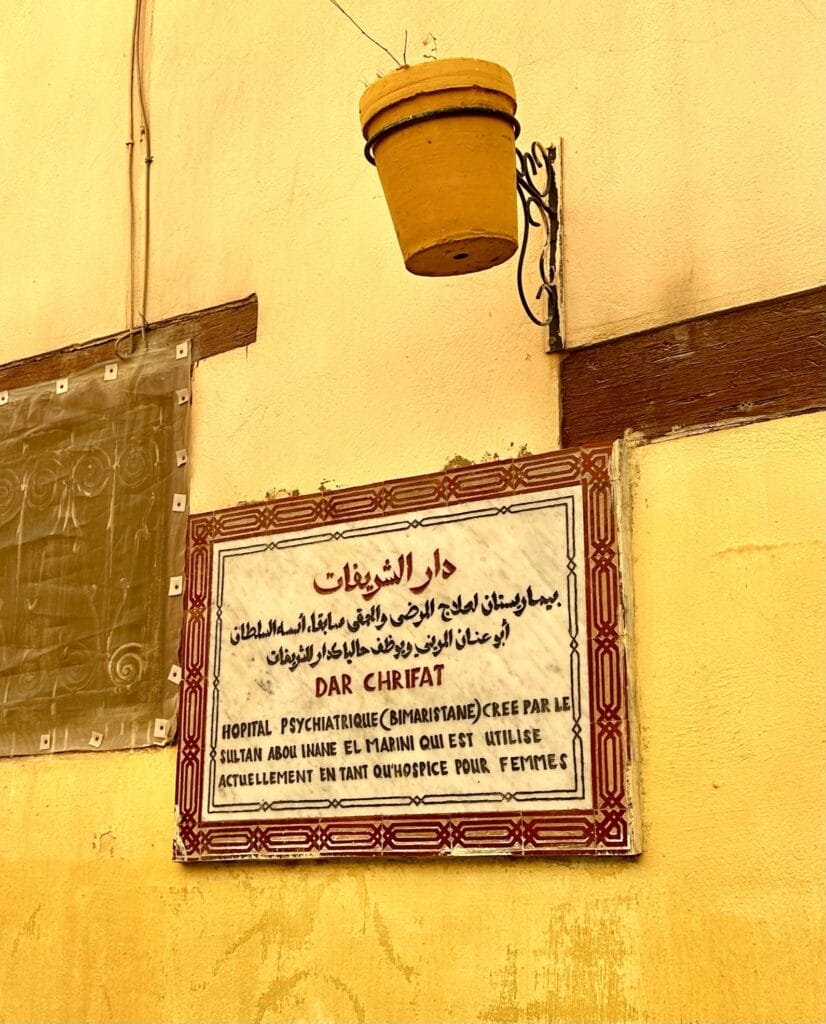














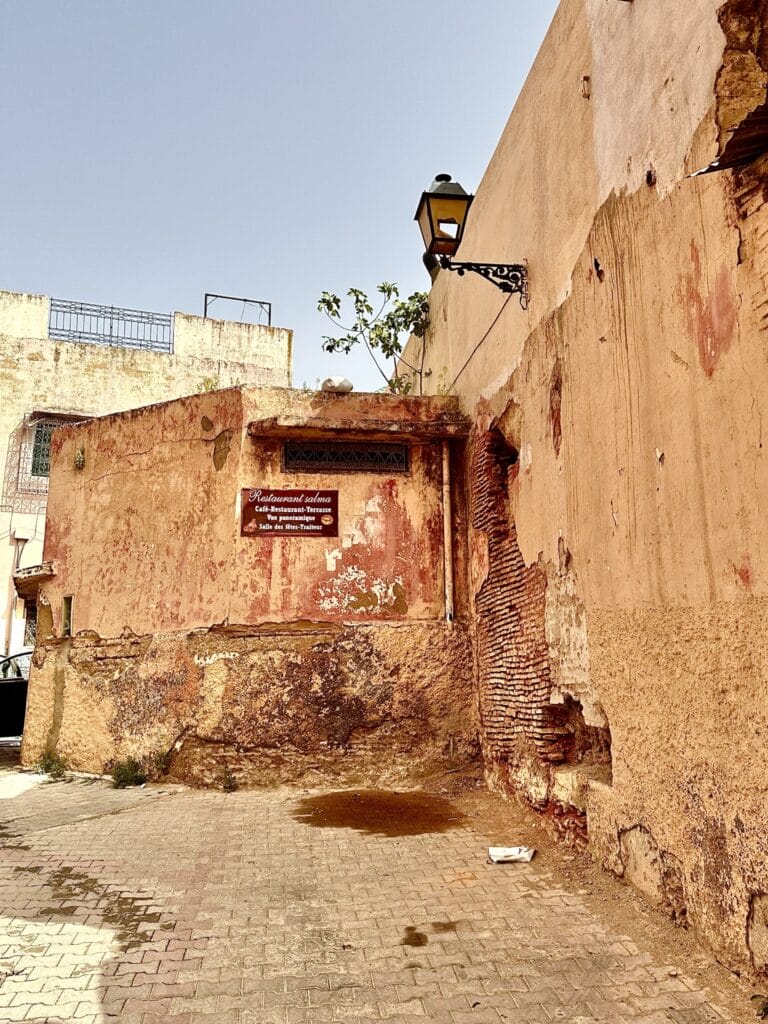



Azilal, Morocco Rural Weekly Market – Atlas Mountains
A tremendous plus of Intrepid is they allow the guides some flexibility in our daily activities. One of our favorite stops was the once-weekly market in Azilal, which by chance, we were driving by. Our Intrepid leader, Hamid, thought it would be a unique experience for the group.
This rural market in the Atlas Mountains serves many Berber villages, some hours away. Despite the country’s increasing urbanization, the agricultural sector in Morocco still supports a large workforce. These rural markets of Morocco are essential to the community in terms of the food and services provided and the socialization that occurs. Hamid’s family comes to this market every week from over an hour away. The majority of shoppers were men, but there were many women present. The market echoed vibrant conversations as the locals connected and caught up on local news.
Each province has a market on any day of the week. The market (souk) is usually in the larger towns or a village, which acts as a center for the surrounding rural area and local farms. It is so important that the town often has the day of the week attached to its name.
Donkeys are part of the family
Many come to these markets on donkeys, and there is a donkey “parking lot” behind the market. While approaching the market, we noticed donkeys tethered at the roadside. We were told farmers ride their donkeys down from their villages in the mountains to the main road, tether them, and catch public transportation or a taxi to the market. There were many cars at the market as well.
The market we visited is mainly on a large dirt field with concrete floored structures for butchers and other products. Produce is often laid down right on the dirt. The weekly market was packed with people bartering for prices. We asked our Intrepid what they do if they didn’t sell all their produce, products, or meat. He said by the end of the day, nothing is left; it all sells.
Though the food was predominantly what was sold, there seemed to be nothing that was not offered. The saying “everything plus the kitchen sink” applies here; everything you can imagine was being sold, including kitchen sinks. There is a vast area of barber tents. Many vendors offer clothing, shoes, cosmetics, doors, spices, household essentials, livestock, naturopathic medicines, blacksmith services, donkey blankets and baskets, animal feed, woven baskets, etc.
We were the only tourists
This is not a place you will find many tourists, if any, and we can say we were likely the only ones there that day. What a fascinating exposure to a world we rarely get to see close up. Though outsiders, we never felt uncomfortable, and we received many smiles. Though it was not a place to purchase anything, we all appreciated the visit.
Our visit to the Azilal market was a marvel and an intimate look at the ingenuity and life of the Moroccan people. The images are a small capture of our experience. The hub of activity was remarkable.

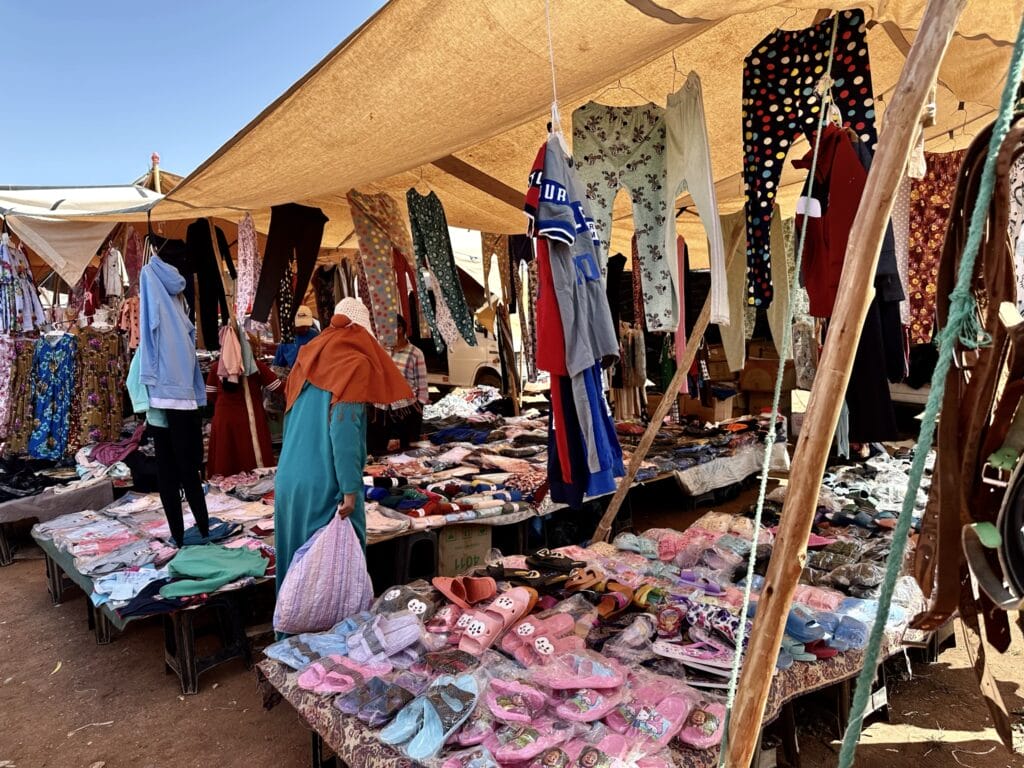





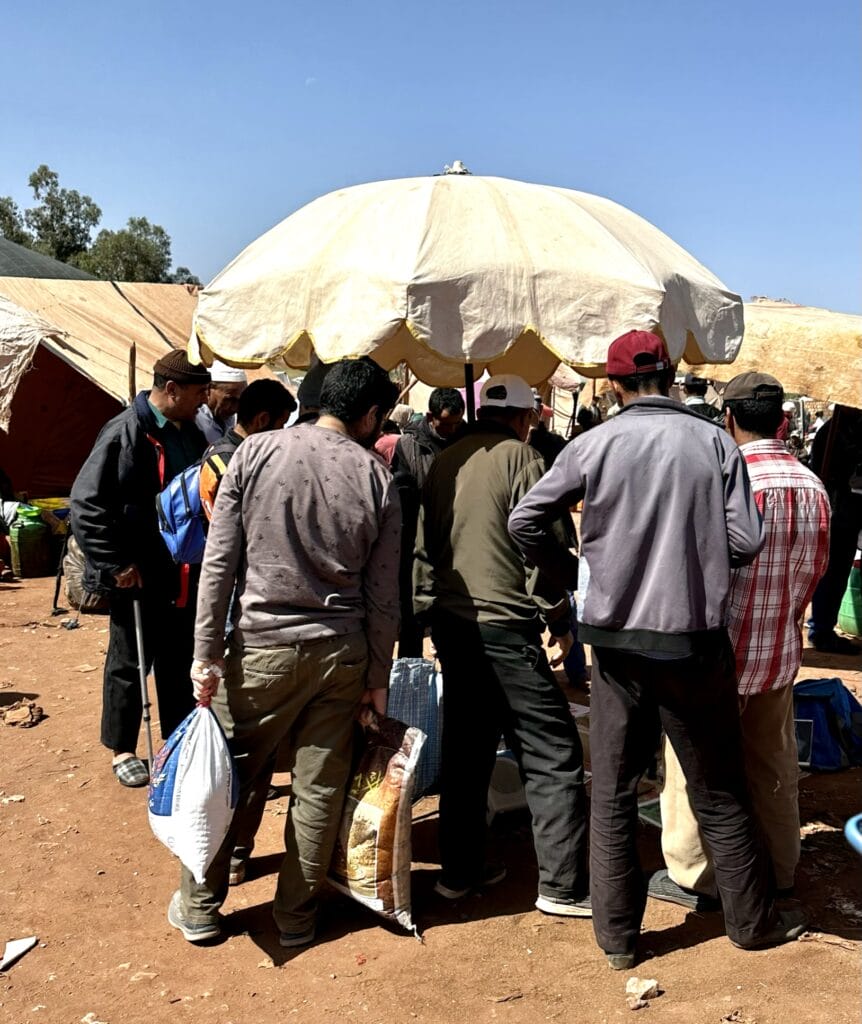
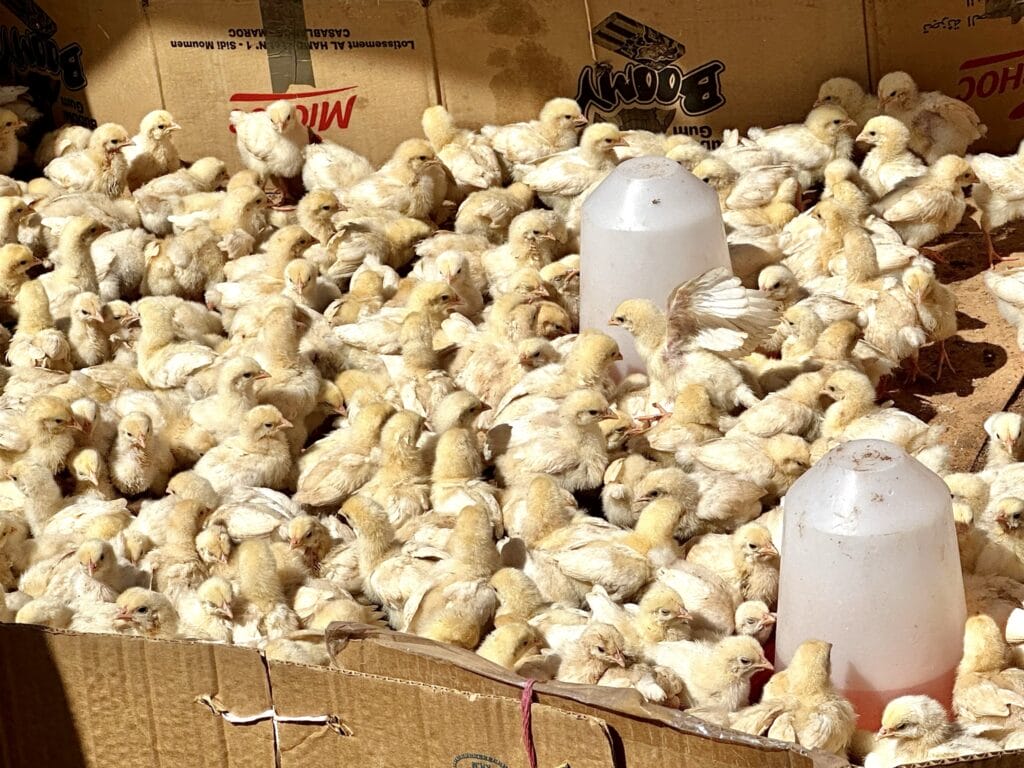



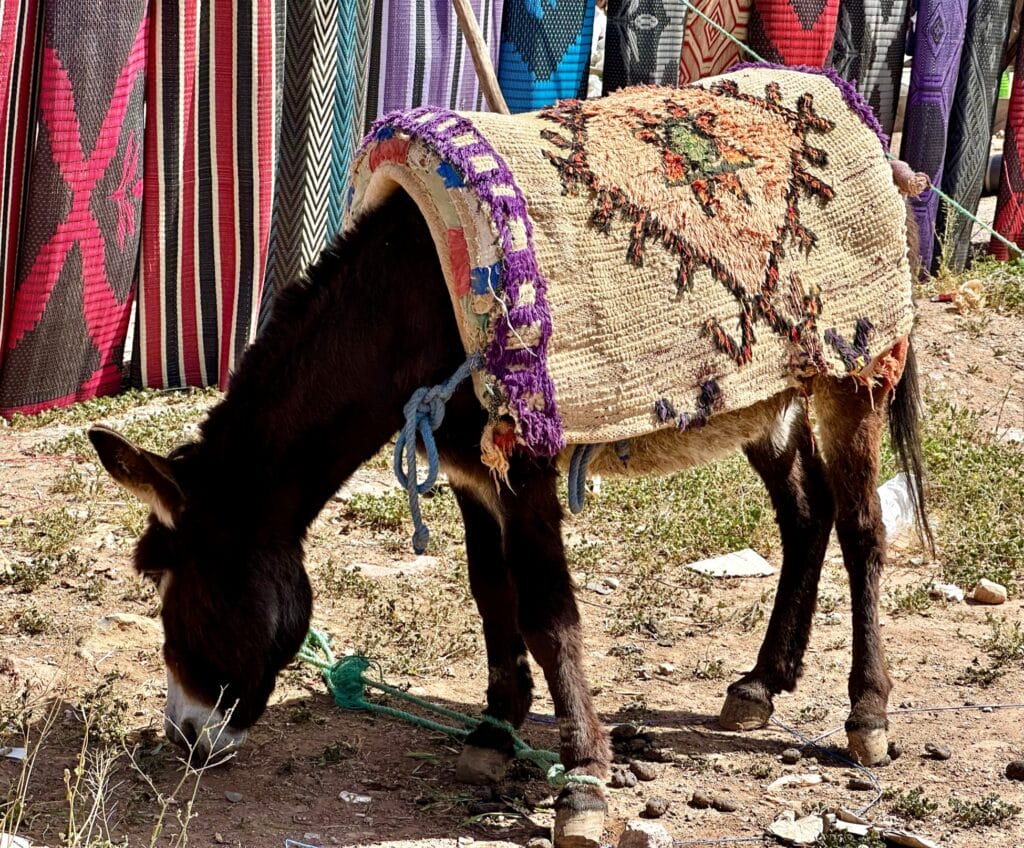


















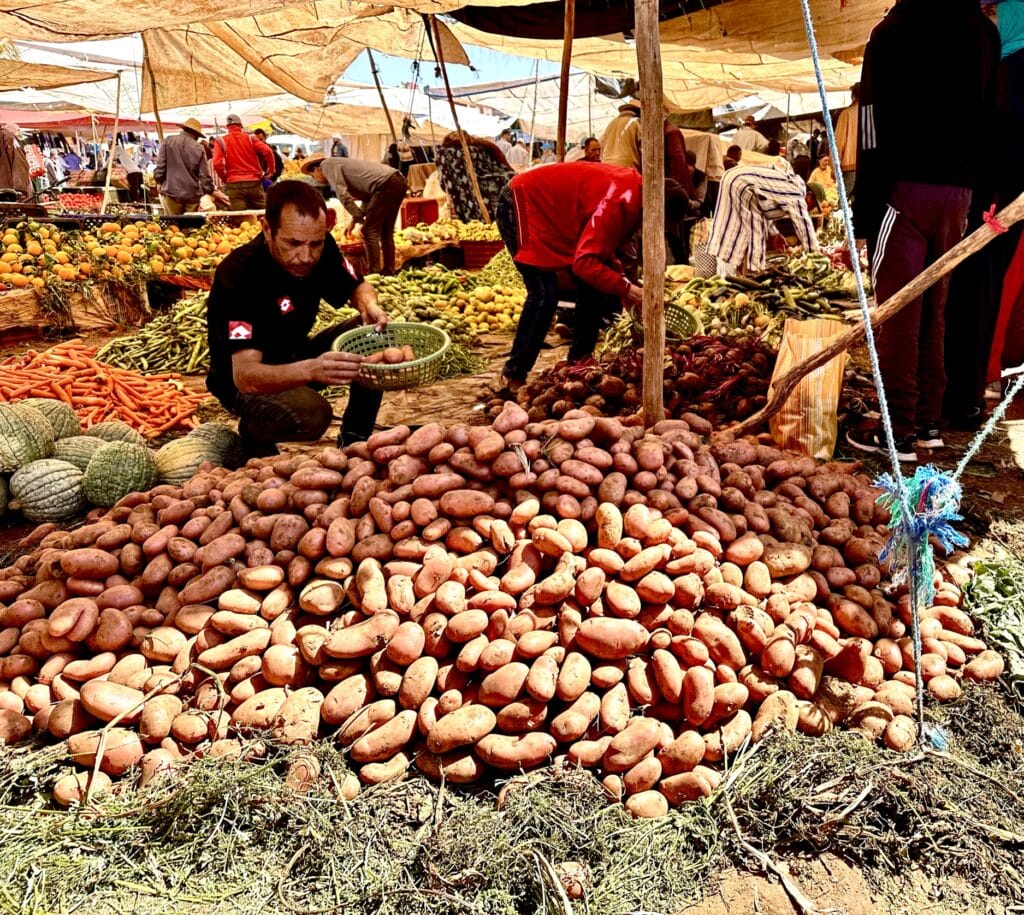

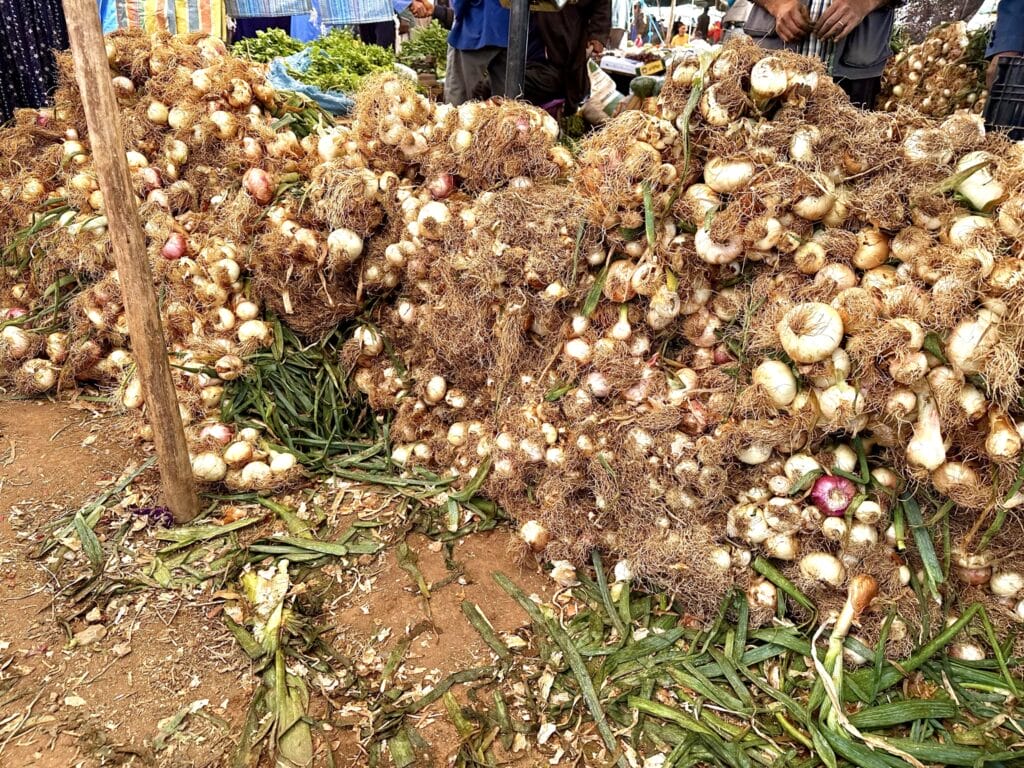
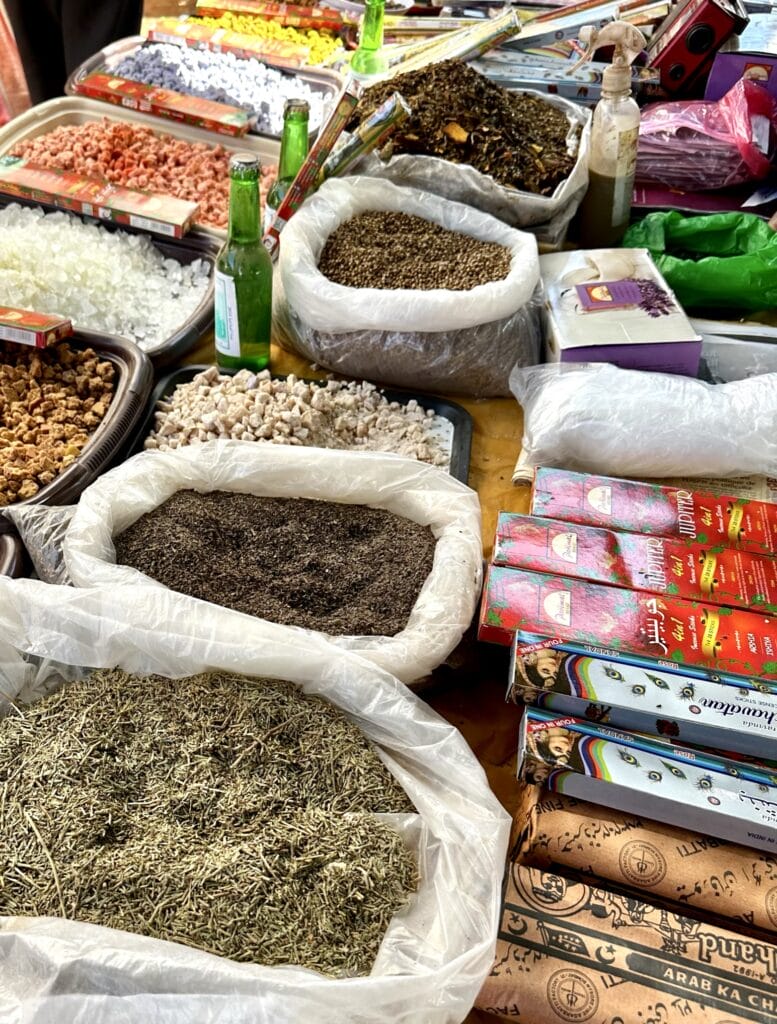



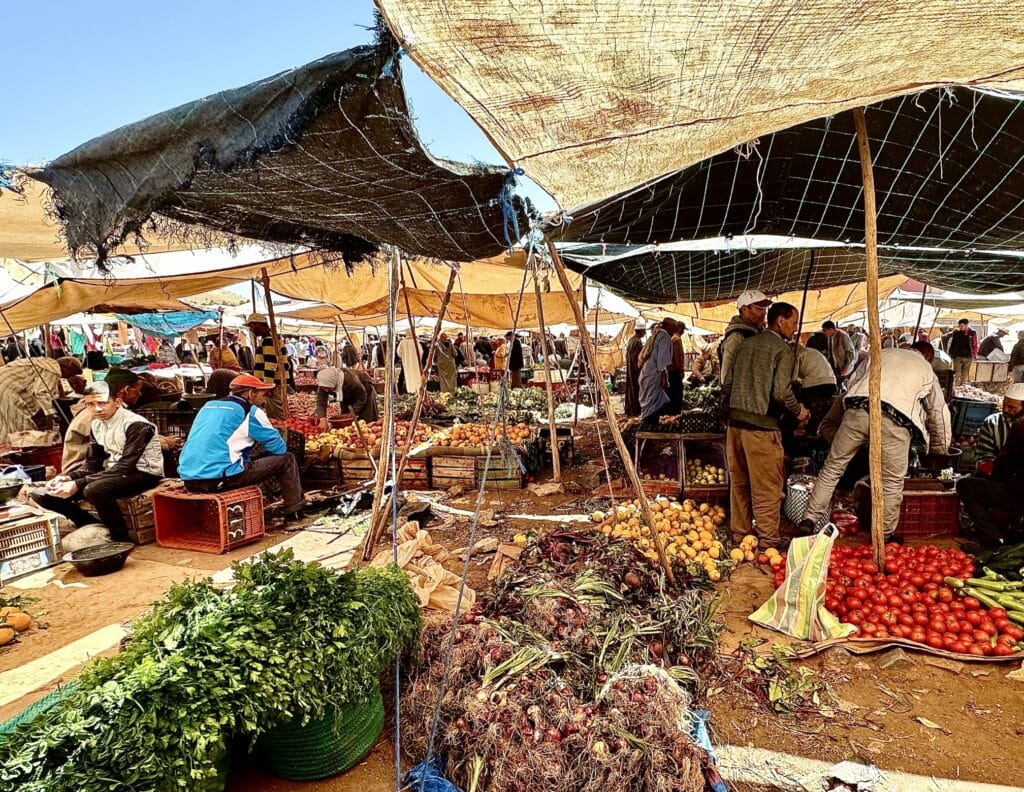






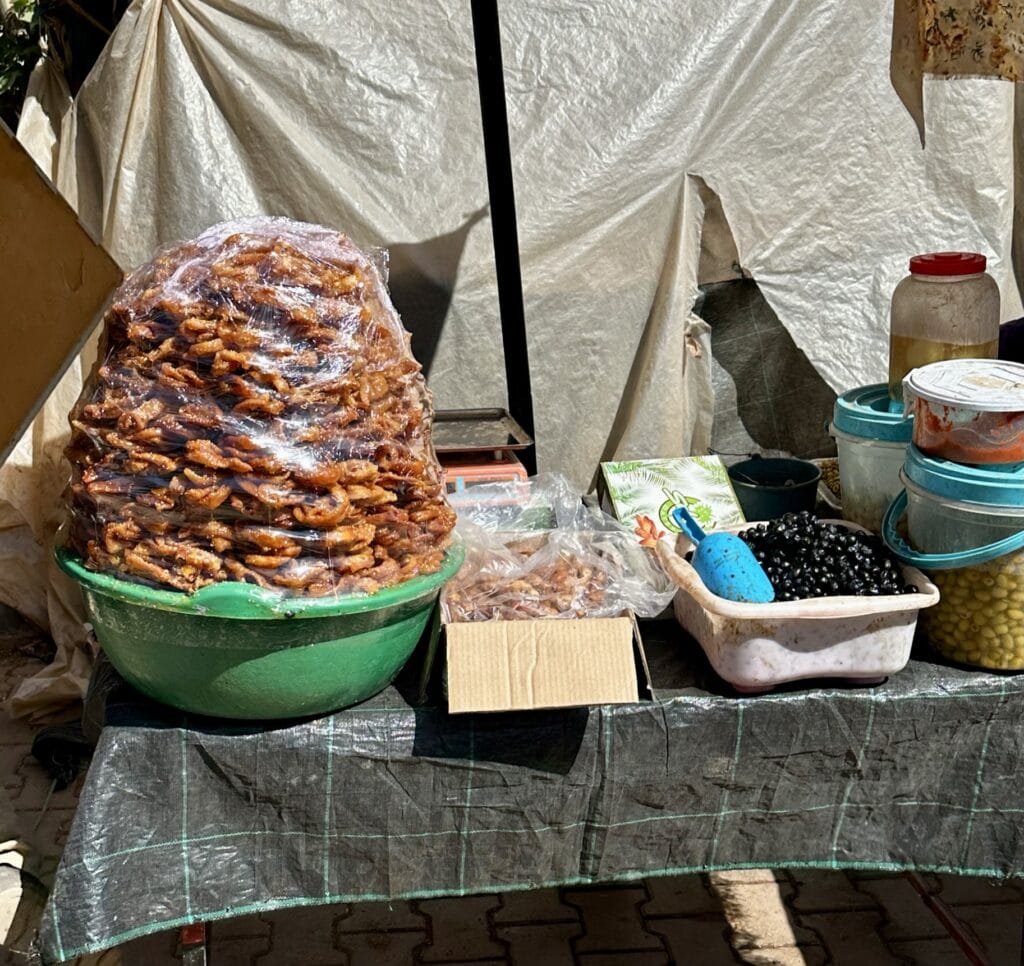


Fes, Morocco
Fes is the oldest of Morocco’s Imperial cities and has served as the country’s capital three times. Today, it is one of the most authentic cities in Morocco, reputed as a center for traditional artists and artisans. Fez’s Medina is a UNESCO World Heritage Site recognized as one of the best-preserved historic towns of the Arab-Muslim world. It is also one of the world’s largest urban pedestrian zones. The city’s most famous building, Quaraouiyine Mosque, is home to the University of Al-Quaraouiyine. Founded in 859, it is believed to be the world’s oldest continuously functioning university. The mosque is also one of Africa’s largest worship centers and can hold up to 20,000 people during prayer time.
During our visit to Fes, we spent most of the day touring the old walled Medina of Fes el Bali, which dates back to the 8th century. The Fes el Bali “labyrinthine” is best explored with a local guide (Intrepid provided an excellent one) as the Medina has 40,000 dead-end alleyways, 9000 streets, 350 Mosques, and 120,000 residents. It is an experience for the mind and senses and the most fascinating of the markets of Morocco we visited. The historic architecture, such as the Madrasas (schools) and Palaces, is captivating. The shopping is incredible within the souk, where we found some of the most exceptional quality products from local artisans. It was the only Medina we visited that we were warned not to enter after dark as it can be dangerous; during the day, we felt entirely safe.
The ancient tanneries
An intriguing piece of our visit was the traditional tanneries in Fes’s leather souk that transported us back to medieval times. Here, skins are cured using archaic ingredients (including cow urine, quicklime, and pigeon feces) and laid out to dry in the sunshine as it has occurred for centuries. The smell is known to be overwhelming, and we were given a fresh sprig of mint to mask it, but we did not feel we needed it. We entered through a leather shop built into the surrounding walls for a bird’s-eye view of the process. Our tannery guide pointed to the home he was born in, overlooking the tannery; generations after generations of families work here. Several in our group bought some lovely leather jackets.



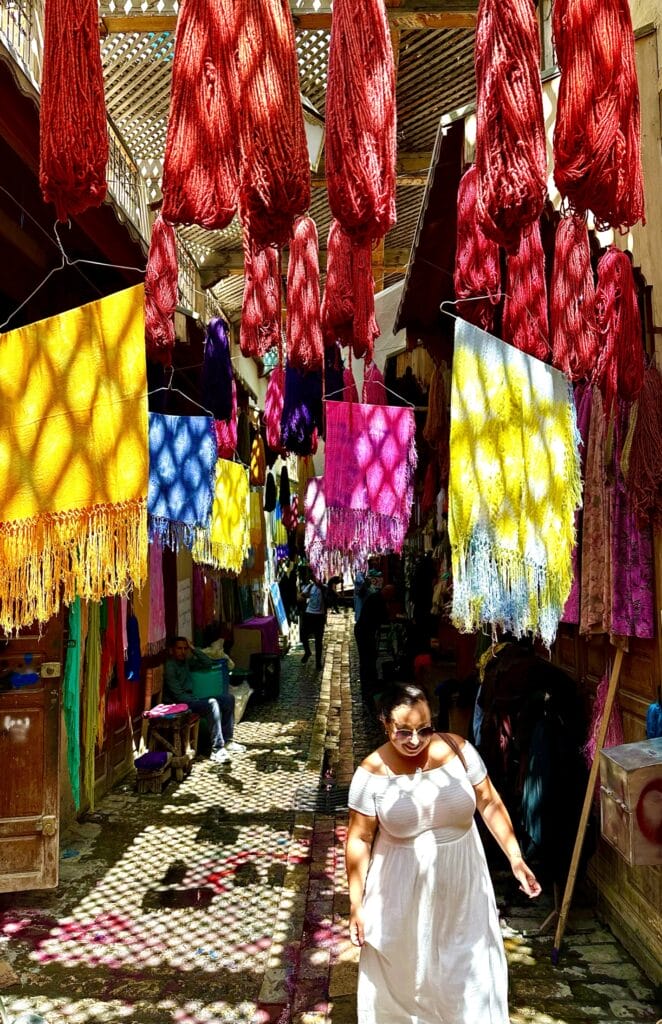























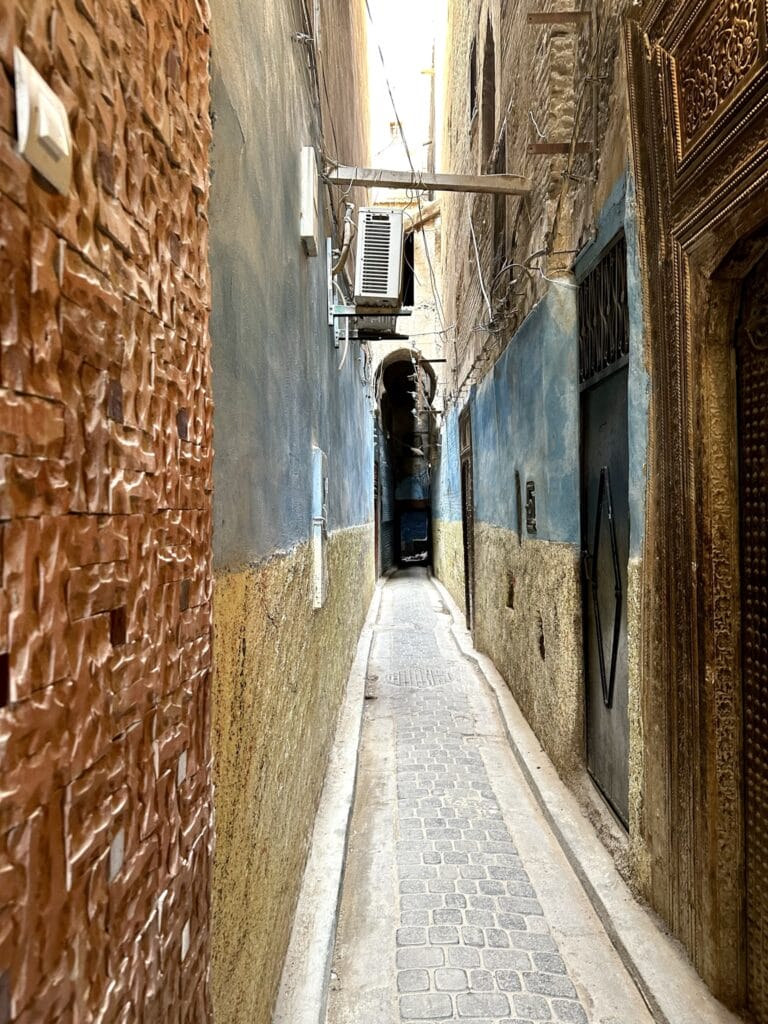


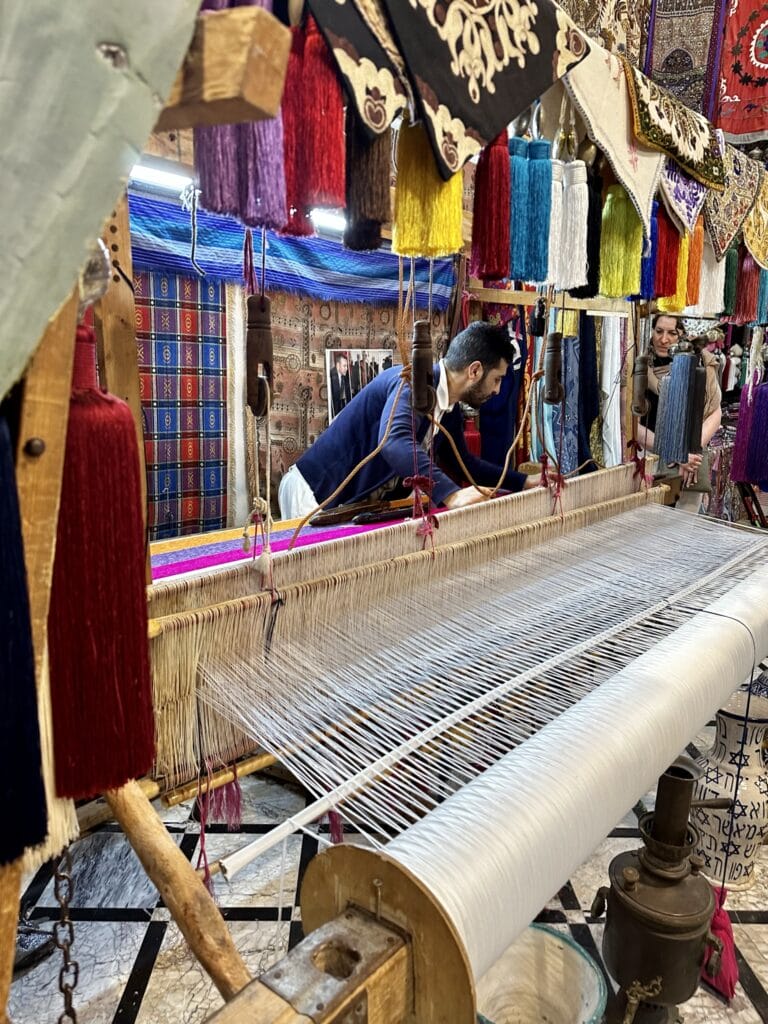
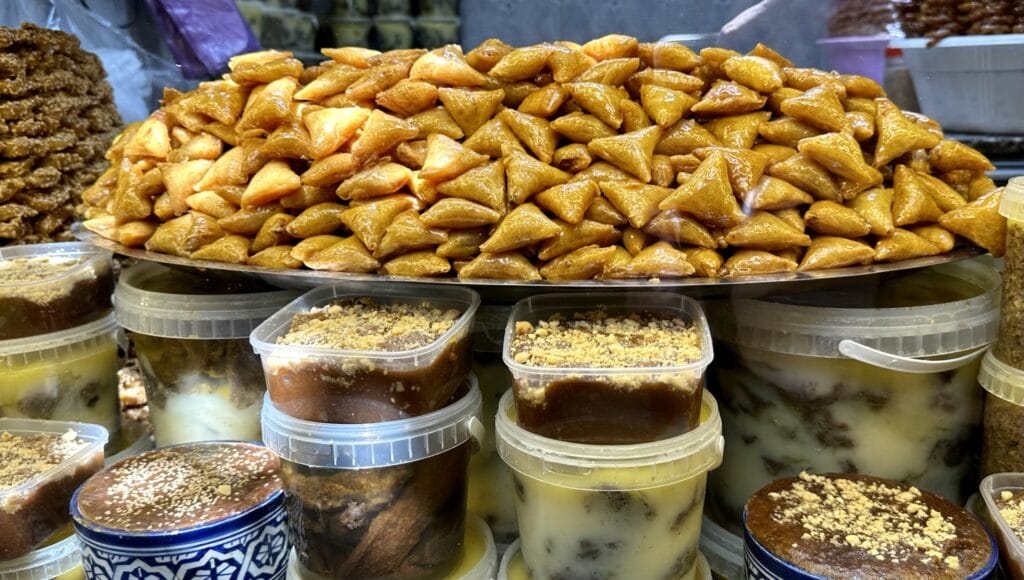
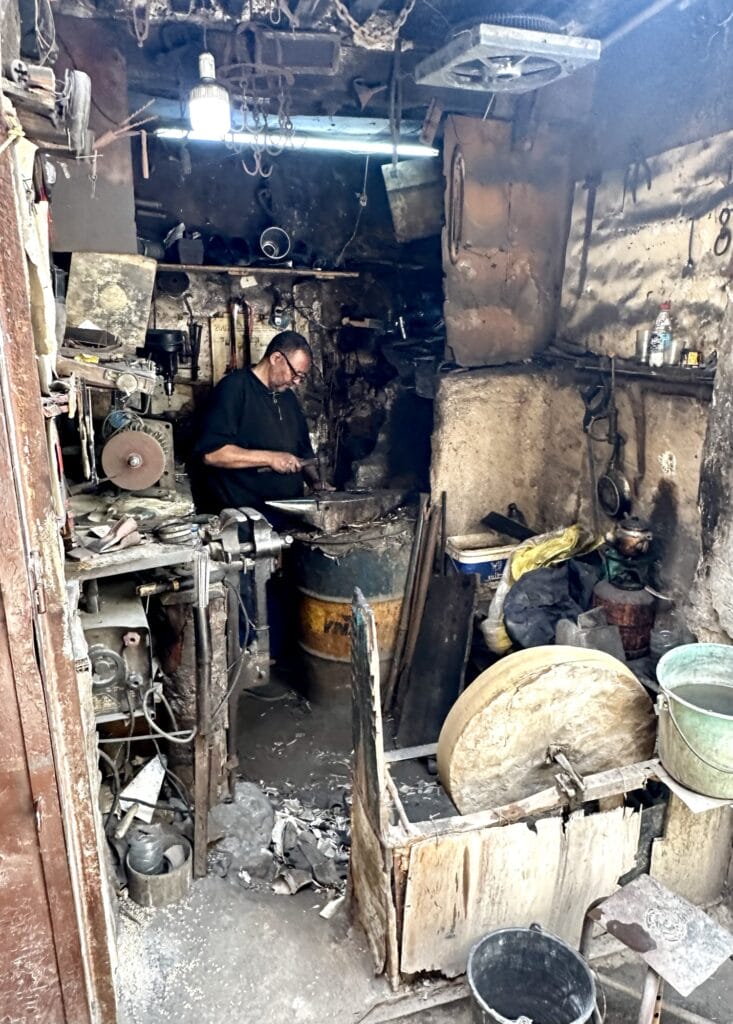












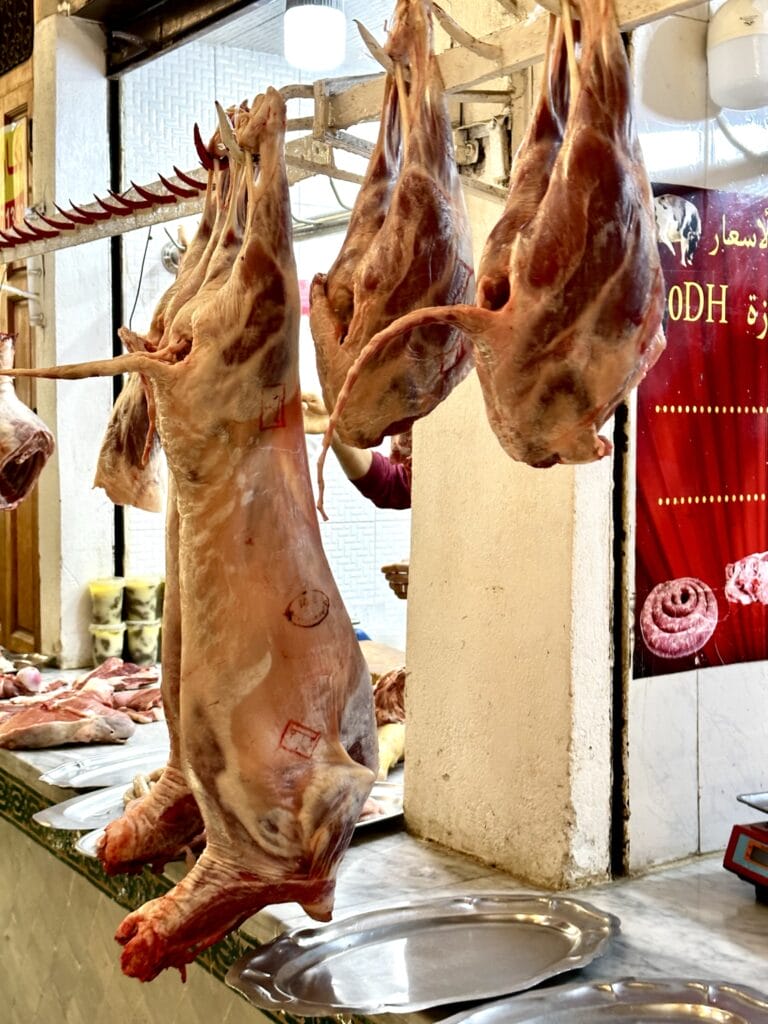


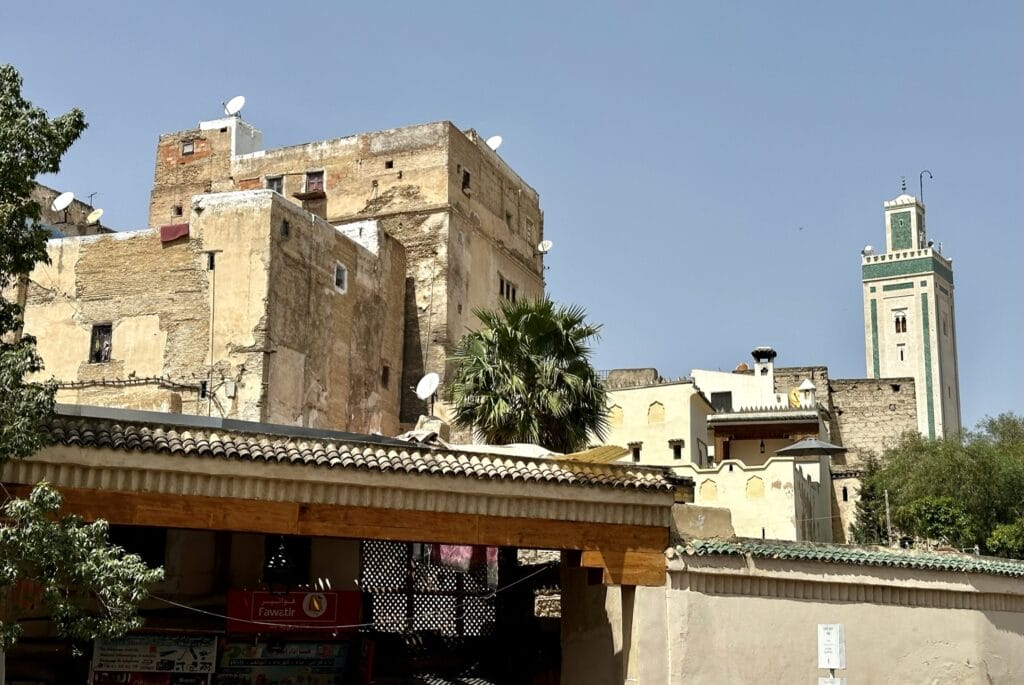














Marrakech, Morocco
Marrakech is the fourth largest city in the Kingdom of Morocco. It is one of the four Imperial cities of Morocco and began in 1070. The city is west of the foothills of the Atlas Mountains.
Berber farmers have inhabited the region since Neolithic times. The Almoravids established the first major structures in the city and impacted its layout for centuries to come. The red walls of the town, built by Ali ibn Yusuf in 1122–1123, and various buildings constructed in red sandstone afterward have given the city the nickname “Red City.” Marrakesh increased in subsequent years, becoming a cultural, religious, and trading center.
Marrakech has a medina that is a designated UNESCO World Heritage Site. The medina ramparts stretch for about 12 miles. The construction was in the 12th century as protective fortifications. The reddish walls stand up to 19 feet high and have 20 gates and 200 towers. Initially, we found the Medina overwhelming as you had to be constantly wary of fast-moving motorbikes flying through the crowded narrow alleyways, missing pedestrians frequently by inches. This was not the case in all the other markets of Morocco. Despite fearing being hit by a motorbike, the Medina and the souks within are fascinating and bustling. The city of Marrakech has 18 souks, the largest of the markets in Morocco. The demand for handmade artisan products employs many Moroccans.
Jena el-Fnaa Square
Jena el-Fnaa, within the Marrakech medina, is the busiest square in Africa. It is called a bridge between the past and the present. It has been a place of trade since early times. At one point, it was where executions by rulers trying to maintain power occurred. Today the square attracts people from diverse social and ethnic backgrounds and visitors from all over the world. Snake charmers, musicians, monkey trainers, herb sellers, storytellers, pastry carts, fresh juice stands, and more populate the square.
It was referred to as more of a bazaar to us, where some of the products you may be buying are not handmade or even from Morocco. There were lots of knockoff athletic shoes, purses, and clothes. The square has four mosques which, when a call to prayer occurs, seem to compete with each other. There are endless restaurant choices, many on rooftops to enjoy the sunset. Jena el-Fnaa is a safe place to wander at all hours, but the vendors are more persistent than in other cities.
Today Marrakech is one of Africa’s busiest cities and is a major economic center and tourist destination. Marrakesh’s real estate and hotel development have grown dramatically in the 21st century. The city is particularly popular with the French, and numerous French celebrities own property there. Culturally it was less strict in the cities, with many Moroccans much less conservatively dressed.
Marrakech is a vibrant, progressive city with beautiful expansive parks, modern buildings, elegant restaurants, and a gorgeous airport. At its heart is an ancient medina that resonates with traditions held firm. It was the perfect ending to our grand Morocco adventure.





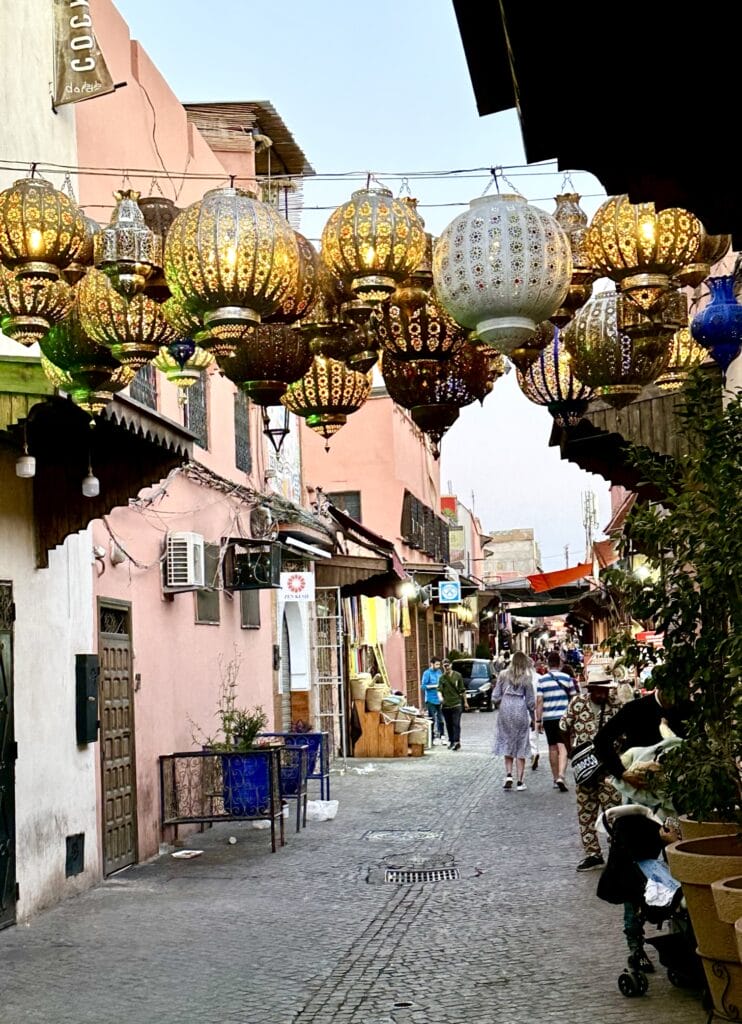












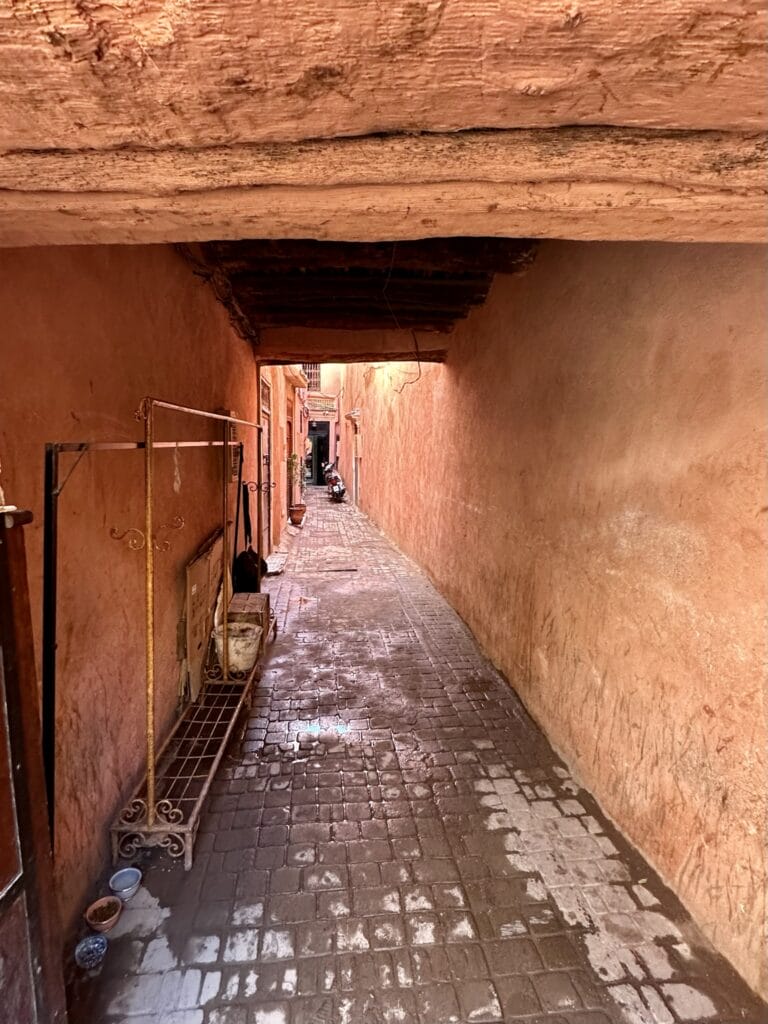



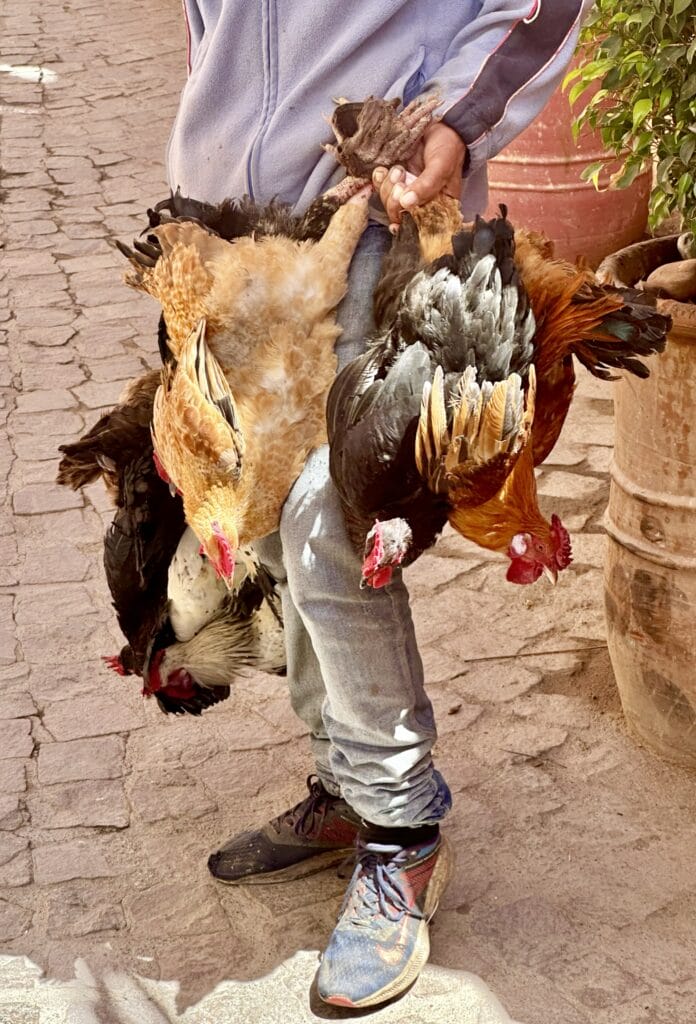








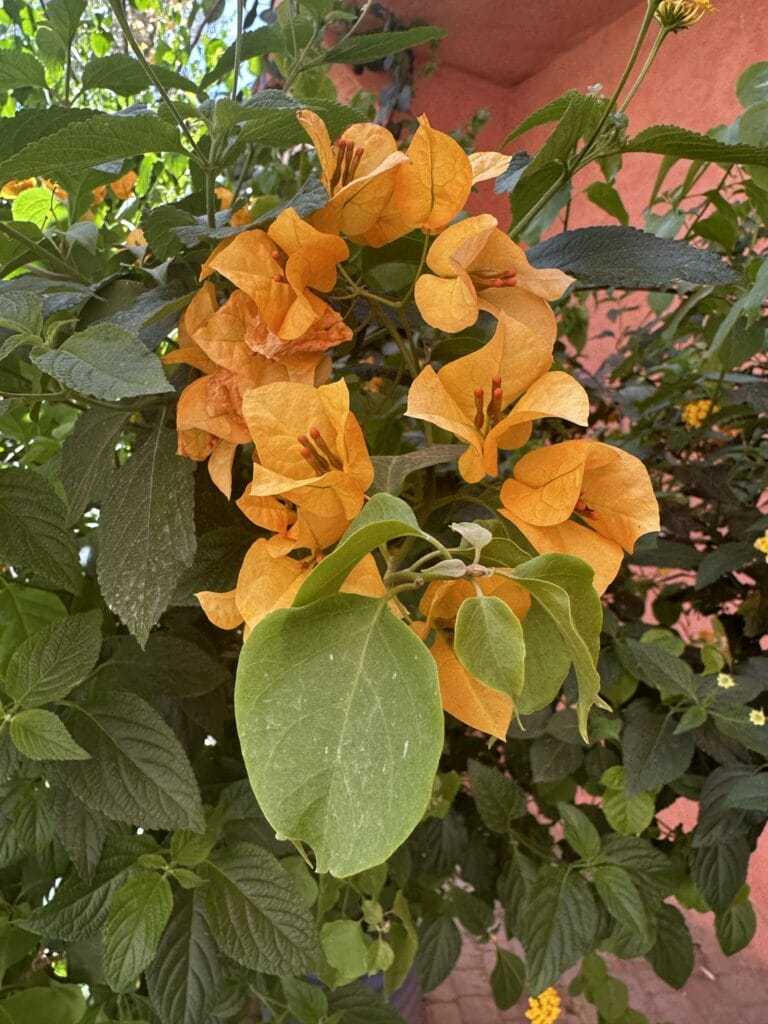
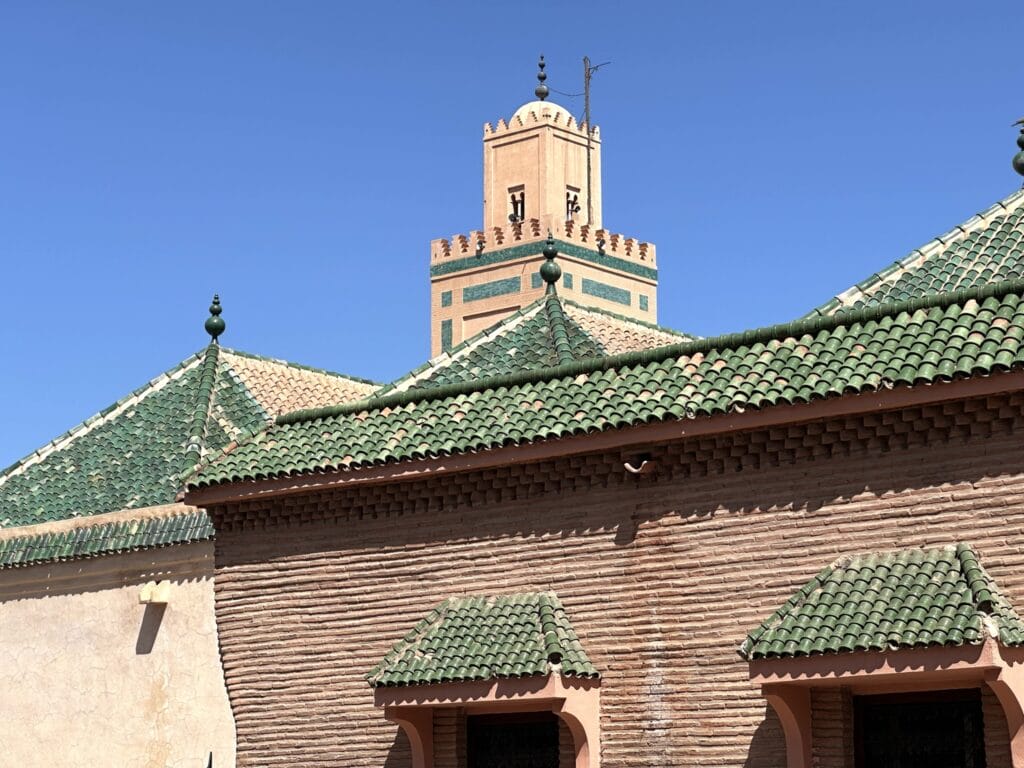
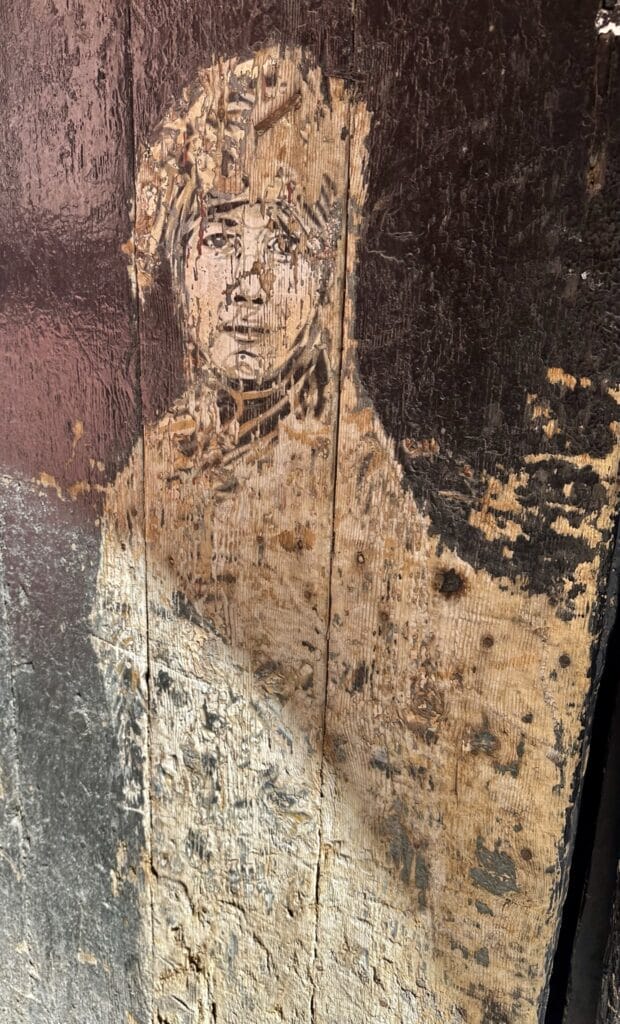










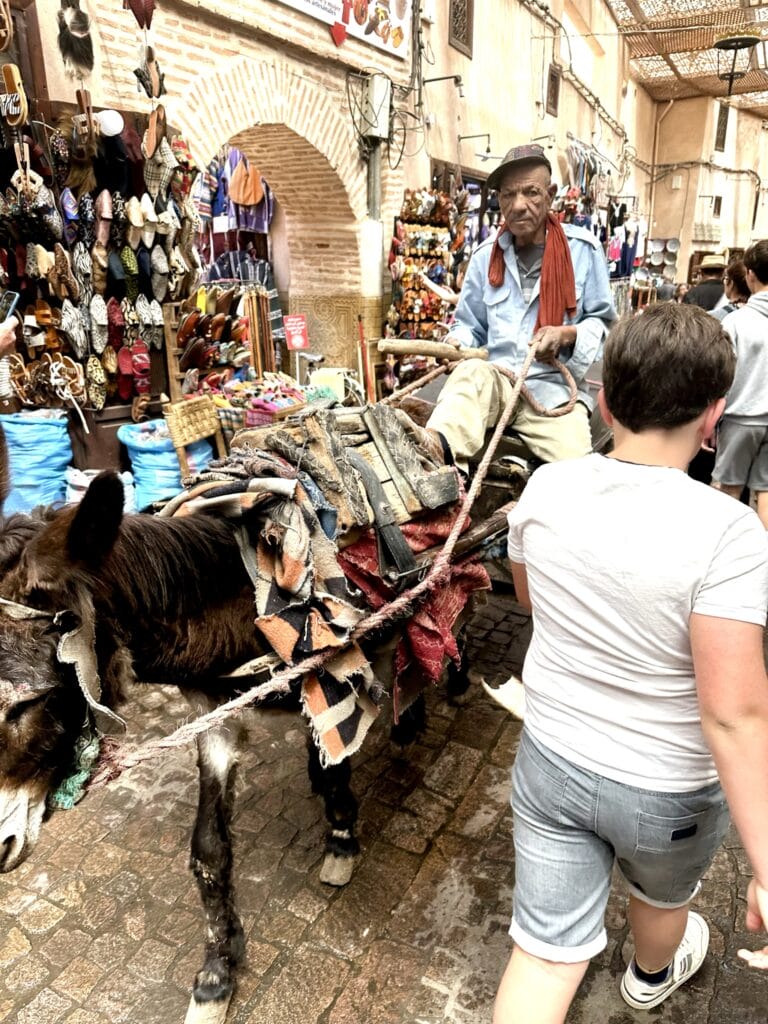


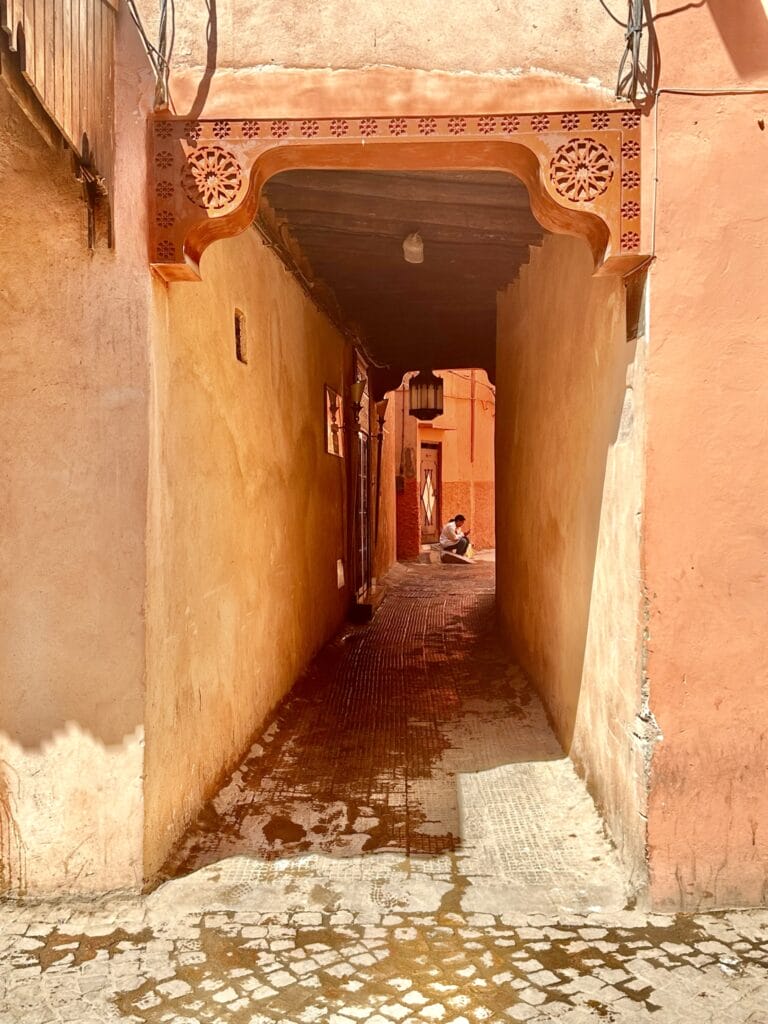




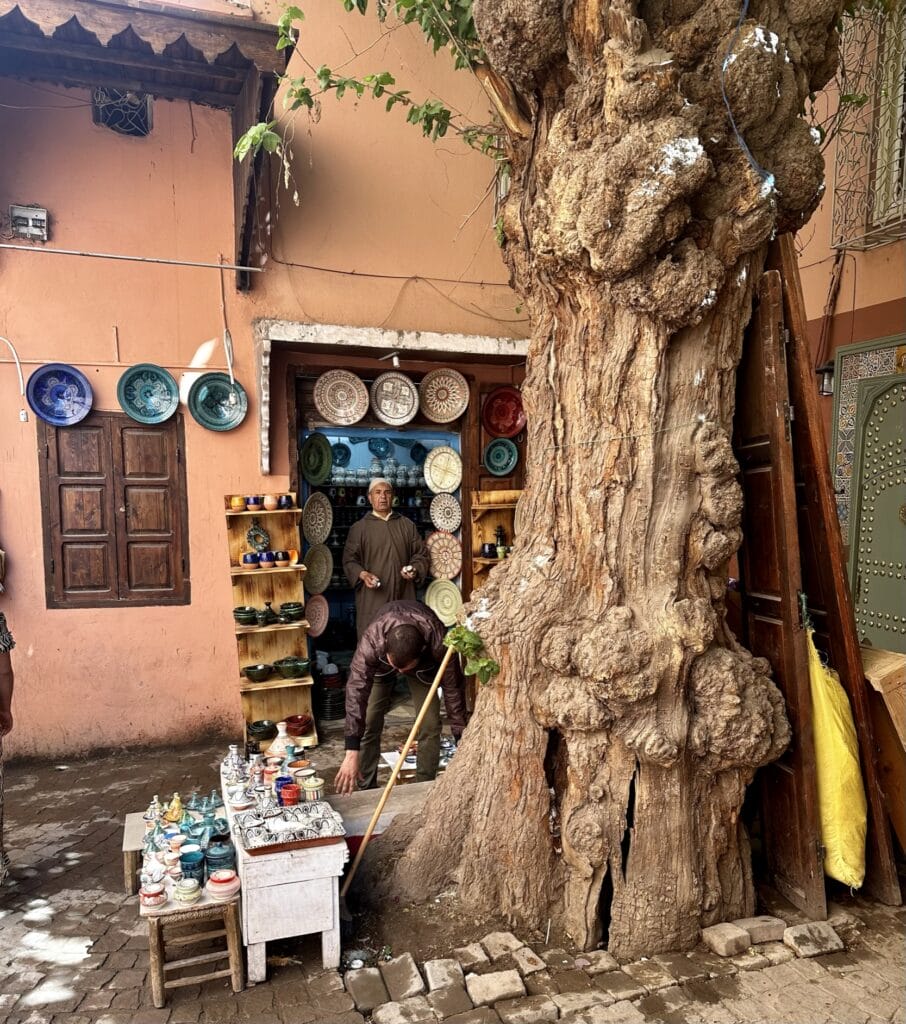






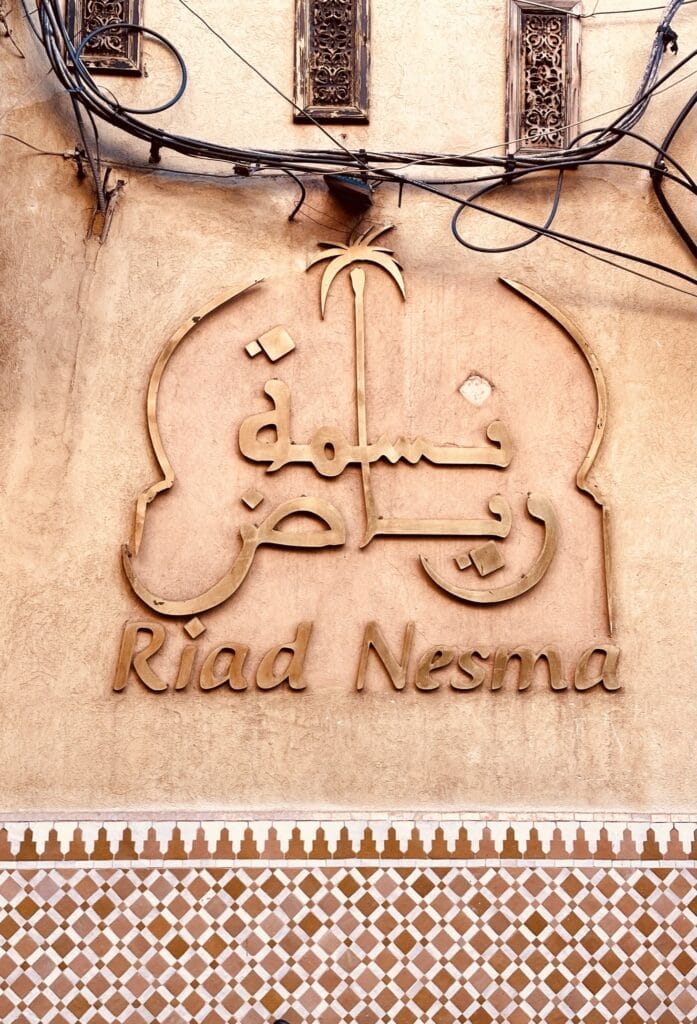






Did you know the US State Department provides travel advisories? Check out the current advisories before planning a trip.
What did we come home with from the markets of Morroco?


To put it simply, we brought home a lot of products for gifts, including argon oil skin products, a silver teapot, a ceramic tagine, tagine spices, artisan plates, clothes, candy, soaps, artwork, etc. If there had been only more room, it would have been even more.
To support tourism, the Moroccan government will ship many higher-end artisan products for free back to your home. That was too tempting. We bought a lovely 8×10 Agave Silk rug that arrived the day after we got home. We purchased a custom-made outdoor tile table that will come in three months. The incredible artisan products we laid eyes on at the markets of Morocco will now be a permanent fixture back home.
Where to stay when visiting the markets of Morocco

Since our post here is on the markets of Morocco, the best place in our view to stay is in a Riad within the Medina. A riad is a traditional Moroccan house or palace with an indoor garden and courtyard. They are usually located within the old medina walls. Riads are very common in Morocco and used to be homes for wealthy merchants and traders. Many Riads in Morocco have been converted into luxury guest houses for travelers. These traditional buildings make for a more authentic and immersive experience. There are many to choose from, but please look carefully at reviews. Try to find one near the entrances to the medinas, as luggage will need to be brought in from there.
We absolutely adored Riad Nesma in Marrakech. You can find it in the two links below.
It is important to price out accommodations on various sites. Expedia is a US-based company, whereas Booking.com is Europe-based. Not all properties appear on both, so it is ideal to check both out. Our personal first choice is Booking.com. If the establishment has a website, check the price there as well. Click the link below to check out hotels and vacation homes in the area. It may be just the motivation you need to start planning that next grand adventure.
Planning a trip this year? Check out our Country Travel Guides
Safety in the Markets of Morocco

Experiencing these markets within our Intrepid tours was ideal for familiarizing ourselves and learning how to maneuver through them. Each market had its unique aspects to which we needed to be sensitive. Fes, for example, would be easy to get lost in and could be scary if you did. Meknes had an edginess, and we felt a little out of place compared to other markets. Marrakech, a more contemporary city, felt less traditional while holding onto those traditions; it was an odd dichotomy.
The biggest surprise was how safe all of these markets of Morocco felt. There are many misconceptions about what to worry about here. We found the Moroccan people welcoming, warm, and friendly. Vendors were surprisingly much less aggressive than most European nations. Female tourists did not seem to be harassed or made to feel uncomfortable like they were in so many places. This is not to say you should not be constantly aware, but it seems you could relax here more than in most destinations. The country is heavily focused on tourism, and it is said there are tourism police among these markets that will crack down on Moroccans who do not behave well. The only place we were warned about safety was entering the souk in Fes after closing hours. In Marrakech, there is no issue at any time of the night. We wandered the Marrakech markets on our own without a guide.
Final Thoughts

After extensive travels in Europe, it was my first visit to the continent of Africa, where Ryan had been before. Despite all my research on Morocco, this beautiful and enchanting country endlessly blew me away. It was hard not to fall in love with the gracious and gentle people we encountered along our journey. I give a lot of credit to Intrepid, for they had us see Morroco at its heart, and without the tour, I don’t think I would have come to appreciate that as much as I have. We were welcomed with open hearts and acceptance everywhere we went. Our job was simple: be a kind and respectful guest of their culture and values.
It has renewed my passion for exploring more remote corners of the world, areas I may have misconceptions about, and places where I can expand my cultural awareness. The markets provided an intimate look into centuries-old traditions and the lives of today’s Moroccans. By sharing their lives and ours, we appreciate our similarities more than our differences. I hope the pictures bring you closer to that as well.
© 2024 Wanderers Compass All Rights Reserved
Check out Morocco’s Offical Tourism Site for more information
Our Top Recommended Travel Products and Services
Travel Insurance
Squaremouth.com
Our favorite travel insurance site!
We could not be stronger advocates of being well-insured—not just for the little stuff but for the big things like medical emergencies. We never leave home without it. Our go-to place is Squaremouth.com. It does a fantastic job with its user-friendly interface and uses top-rated and reputable insurance carriers. They also mediate on your behalf if you have problems.
To empower you as a consumer, we suggest you read our blog post on the importance of travel insurance and how to get the best coverage from top-rated companies for an affordable price.
MedjetAssist
Medical transport back home from anywhere in the world
They are the premier global air medical transport. One caveat to travel insurance is that medical evacuation usually gets you to the closest facility to care for you. Medjet gets you back to the U.S. to the hospital of your choice once you are stable enough to fly. A Medjet membership is only for medical transport. Medjet Horizon offers expanded coverage. They have individual trip policies starting at $99 and annual policies for around $300. Most of their policies limit the age to 74.
To learn more about how Medical Evacuation membership with Medjet Assist works, check out our blog post for a more detailed review.
Accommodations and Airfare
Expedia and VRBO
Hotels, home rentals, BNBs, flights, and other transportation & tours
Expedia is a US-based company whose mission is to power global travel for everyone and everywhere. Wanderers Compass focuses on independent travel, and using sites like Expedia makes that possible. Every aspect of travel you need, from airfare, accommodations, rental car, and cruises to activities to do at your destination, can be booked on Expedia.
Booking.com
Hotels, Home rentals, BNBs, Flights, and other Transportation & Tours
Booking.com connects millions of travelers to memorable experiences, various transportation options, and incredible places to stay – from homes to hotels and much more. It is one of the world’s largest travel marketplaces for established brands and entrepreneurs of all sizes. It is our preferred booking site.
Transportation
Daytrip
Personalized city-to-city private car transfer service
Daytrip is an affordable private car service for city-to-city transfers around the world. We love their service, and it costs much less than renting a car. You can enjoy comfortable, stress-free travel with the added bonus of scenic sightseeing stops along your journey. For example, we used them between Budapest and Vienna, making some fantastic stops along the way. Their professional drivers and customizable routes ensure a smooth ride while allowing you to explore hidden gems and local attractions.
To learn more about how Daytrip, check out our blog post for a more detailed review.
Travel Experiences
Viator
The leading marketplace for travel experiences
Viator believes that making memories is what travel is all about. And with 300,000+ experiences to explore—everything from simple tours to extreme adventures (and all the niche, interesting stuff in between)—making memories that will last a lifetime has never been easier. We use them often during our travels and love their liberal cancellation policy.
Communication products for seamless connectivity overseas
GigSky International eSIM Data Plans
Local Prices. No Roaming. Fastest Networks.
GigSky eSIM keeps travelers seamlessly connected worldwide without the hassle of swapping physical SIM cards or facing unexpected roaming charges. With affordable data plans and instant activation, you can enjoy reliable internet access in over 190 countries, making travel more convenient than ever. They have a great offer, a 100 MB data plan for free, and no credit card is required. They are that confident you will love their product!
Enjoy 10% off all GigSky Plans (except cruise and inflight) with our discount code WCOMPASS10
To learn more about how GigSky, check out our blog post for a more detailed review.
Shopping
Wanderers Compass Amazon Storefront
An excellent source for all travel essentials and guides
Amazon is one of the most comprehensive online shopping sources in the world. Teams worldwide provide lower prices, better selection, and rapid delivery on behalf of customers. They offer a vast inventory, and their 1.7 million small and medium businesses worldwide selling on Amazon.com offer extensive options to customers.
This article contains affiliate links. If you use these links to buy something, we may earn a small commission at no additional cost to you. Thank you!
Want to learn about Wanderers Compass?
Check out most recent blog posts
Hilton Buenos Aires: Discover Luxury, Elegance, and Vibrant Puerto Madero
The Hilton Buenos Aires, located in the vibrant Puerto Madero district, offers luxurious accommodations,…
July 26, 2024Travel Transformed My Life: A Journey of Growth and Discovery
Ryan’s journey demonstrates how travel profoundly changed his life, from a challenging childhood to…
July 25, 2024Discover the Magic of Ghent, Belgium: A Timeless Beauty
Ghent, Belgium, is a cultural treasure in the Flemish region, boasting medieval architecture, a…
July 25, 2024Unlocking Worldwide Connectivity: How GigSky eSIM Makes Traveling Easy for Everyone
In an increasingly connected world, reliable mobile data while traveling is essential. After experiencing…
July 23, 2024Why Daytrip Personalized Car Service is the Smart Choice for Travelers
Daytrip car service offers convenient, personalized city-to-city transfers with local drivers, modern vehicles, and…
July 23, 2024The Issue with Resort Fees: A Call for Transparency and Fair Pricing
Travel enriches lives by immersing us in new cultures and creating lasting memories. However,…
July 21, 2024Are These 5 Top Destinations On Your List?
“I travel not to go anywhere, but to go. I travel for travel’s sake.…
July 21, 2024Unveiling the Secrets of Malta: History, Beauty, and Resilience
There is no rose without thorns maltese proverb Mighty Malta Malta is a tiny island…
July 9, 2024Top 25 Tips for Traveling Abroad: Your Ultimate Guide
Increase your odds of smooth travels and reduce stress by using our top 25…
June 21, 2024Cinque Terre Visitor Guide and Photo Gallery
Everything you need to know to plan your perfect Cinque Terre visit “Italy is…
May 27, 2024












No Comments